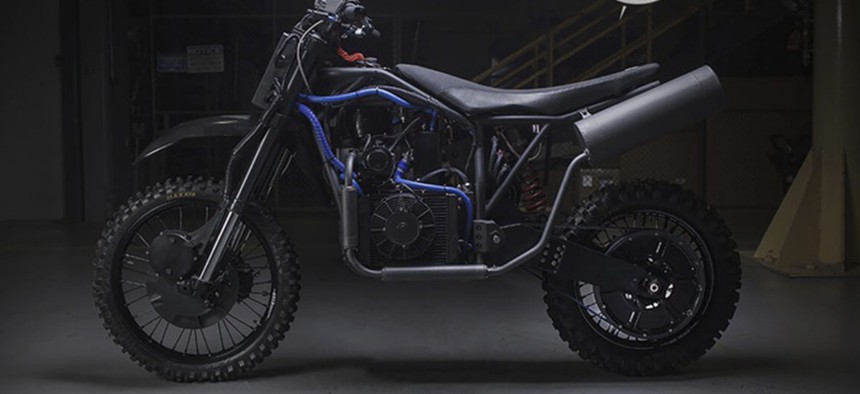A Look At the Military’s New Stealth Bikes

The Nightmare Stealth Bike from LSA Autonomy LSA Autonomy
These motorcycles of the future are turning heads at special operations conference in Florida.
TAMPA, Fla. — What runs on electricity and mystery fuel, moves at 80 miles per hour, generates enough power to run communications gear and is quieter than a conversation? Say hello to the military’s stealth motorbike.
The Defense Advanced Research Projects Agency, or DARPA, launched the stealth bike competition back in 2014. Today, the two prototypes faced off on the expo floor of the of the Tampa Convention Center, part of the National Defense Industrial Association’s Special Operations Forces Industry Conference.
The Silent Hawk by Logos and the Nightmare from LSA Autonomy could be cousins. DARPA has funded both to phase two development under a small business innovative research award, essentially two noncompeting grants to develop the technology.
Both bikes feature cutting-edge hybrid multifuel engines that can burn a variety of combustibles like JP-8, Jet A-1, gasoline, propane, etc.
“If it’s gasoline, tell it it’s gasoline, tell it it’s something else. It will figure it out,” said Alex Dzwill, an engineer with Logos.
Could you run it on lipids, olive oil?
“Theoretically, yeah,” Dzwill said.

Of course, running a bike on regular fuel is loud, which runs contrary to the idea of a “stealth bike.” When not operating in quiet mode, both are as loud as a garbage disposal, roughly 80 decibels.
When operating in quiet mode, both rely on a lithium-ion electric battery, which keeps the noise down to around 55 decibels, about as loud as an indoor conversation.
Of course, lithium ion batteries, at one point, developed a bit of reputation for blowing up.
The Silent Hawk’s electric system is from Alta Motors.
“They have purpose built this battery pack to be of higher density … They have an active cooling system in it that insures that even if there is a cell failure that one cell will fail with no explosion. It will remain operational,” Dzwill said. It’s very similar to the multicell system in today’s Tesla cars.
“Our system is a bigger brother,” said Jean-Marc Henriette, chief engineer at LSA Autonomy, which makes the Nightmare. “We’ve got a much bigger bike for the same type of requirements.”
The Nightmare weighs in at about 400 pounds, compared to 350-pound Silent Hawk. Both bikes feature a front-wheel motor and rear motor but the Nightmare boasts a larger horsepower, 17 in front and 135 in back. The Nightmare averages around 13 kilowatts in generated power, versus 7.5 kilowatts for the Silent Hawk. Both have the ability to run external devices, too.
What’s left to want in a bike, except self-driving capability?
“If the end user was interested in that feature,” Dzwill said, adding he would would look into it.
“That’s something that’s been talked about,” Henriette said.
It’s even been done. One of the entries in the 2005 DARPA Grand Challenge was a self-driving bike that actually performed well (check out the video below around the 1:38 mark).
Unfortunately, a self-driving bike is less fun.






